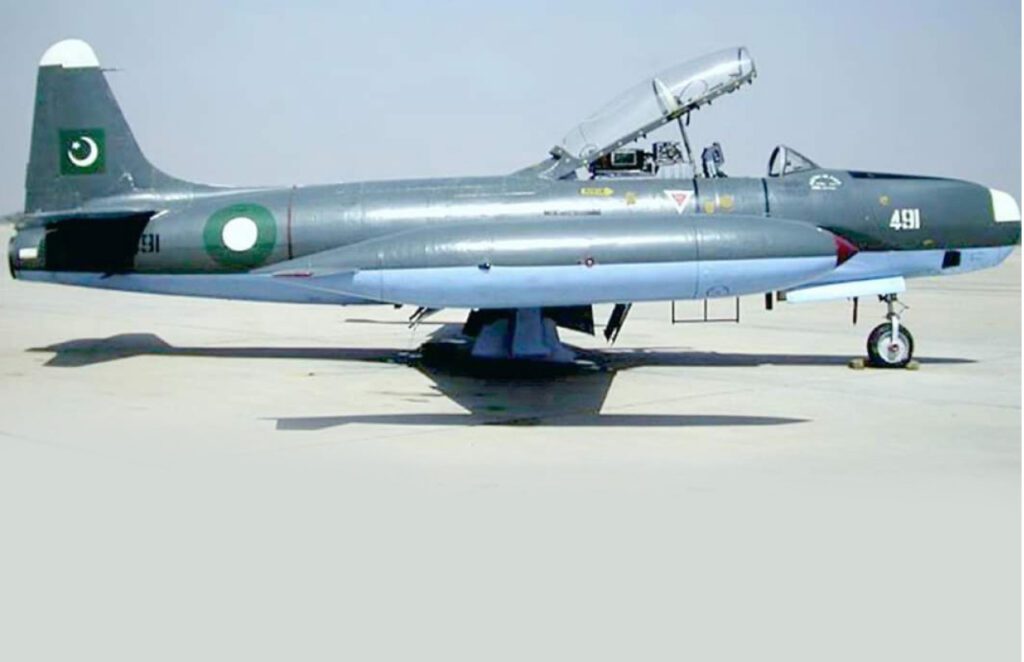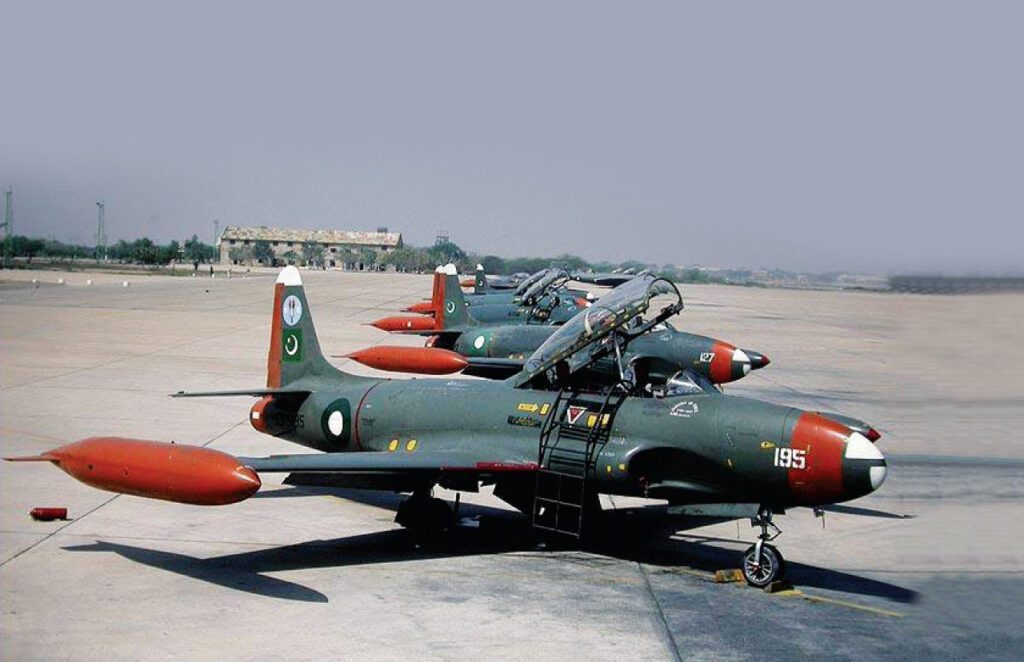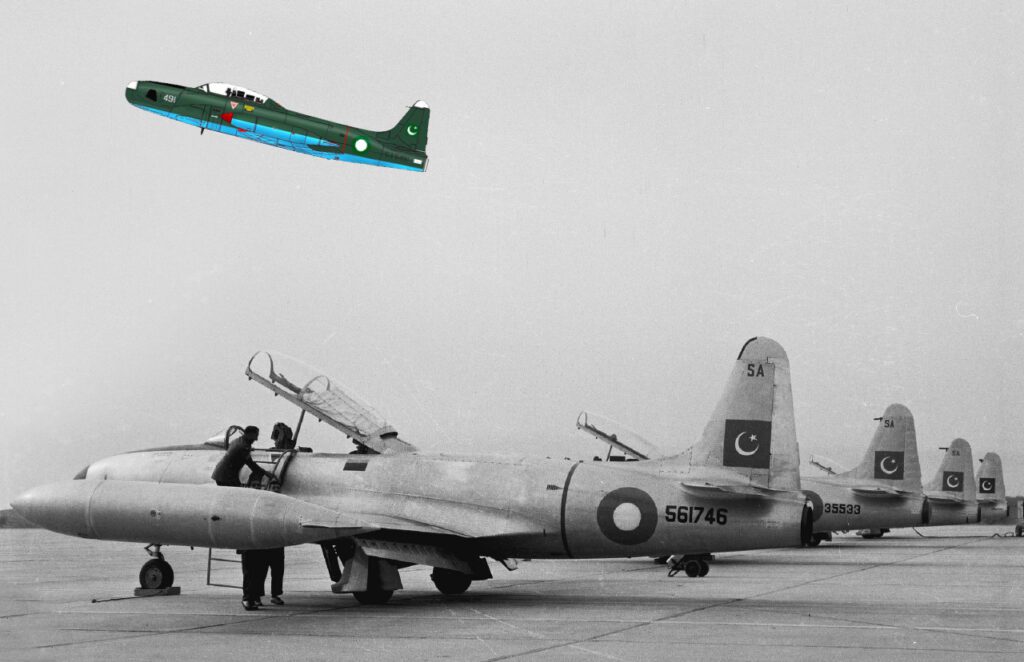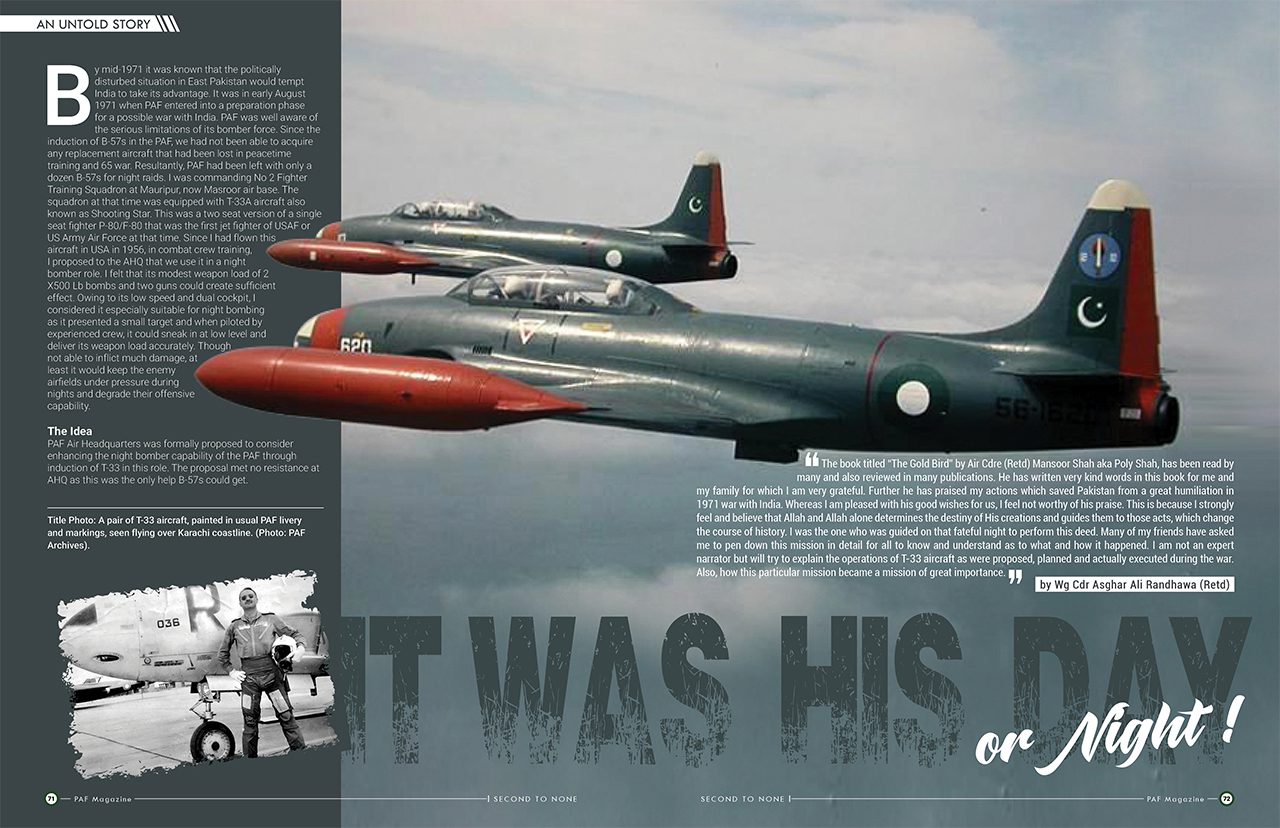The book titled “The Gold Bird” by Air Cdre (Retd) Mansoor Shah aka Poly Shah, has been read by many and also reviewed in many publications. He has written very kind words in this book for me and my family for which I am very grateful. Further he has praised my actions which saved Pakistan from a great humiliation in 1971 war with India. Whereas I am pleased with his good wishes for us, I feel not worthy of his praise. This is because I strongly feel and believe that Allah and Allah alone determines the destiny of His creations and guides them to those acts, which change the course of history. I was the one who was guided on that fateful night to perform this deed. Many of my friends have asked me to pen down this mission in detail for all to know and understand as to what and how it happened. I am not an expert narrator but will try to explain the operations of T-33 aircraft as were proposed, planned and actually executed during the war. Also, how this particular mission became a mission of great importance.
By mid-1971 it was known that the politically disturbed situation in East Pakistan would tempt India to take its advantage. It was in early August 1971 when PAF entered into a preparation phase for a possible war with India. PAF was well aware of the serious limitations of its bomber force. Since the induction of B-57s in the PAF, we had not been able to acquire any replacement aircraft that had been lost in peacetime training and 65 war. Resultantly, PAF had been left with only a dozen B-57s for night raids. I was commanding No 2 Fighter Training Squadron at Mauripur, now Masroor air base. The squadron at that time was equipped with T-33A aircraft also known as Shooting Star. This was a two seat version of a single seat fighter P-80/F-80 that was the first jet fighter of USAF or US Army Air Force at that time. Since I had flown this aircraft in USA in 1956, in combat crew training, I proposed to the AHQ that we use it in a night bomber role. I felt that its modest weapon load of 2 X500 Lb bombs and two guns could create sufficient effect. Owing to its low speed and dual cockpit, I considered it especially suitable for night bombing as it presented a small target and when piloted by experienced crew, it could sneak in at low level and deliver its weapon load accurately. Though not able to inflict much damage, at least it would keep the enemy airfields under pressure during nights and degrade their offensive capability.
The Idea

PAF Air Headquarters was formally proposed to consider enhancing the night bomber capability of the PAF through induction of T-33 in this role. The proposal met no resistance at AHQ as this was the only help B-57s could get.
Furthermore, in those days UK had supplied additional Canberra aircraft to India, which had further increased the strength of their bomber force. Soon, I was tasked to go ahead with the proposed modifications and develop a plan for using T-33 aircraft as night bombers. From then onwards, there was no looking back. First we started to search for the bomb racks, which were luckily found at the depot at Drigh Road (now PAF Base Faisal). With little modifcations, the bomb stations were established and racks were installed on one aircraft. Initially, the aircraft was flown with minimum fuel and two bombs. Later, different fuel loads were used with bombs to ensure that aircraft got safely airborne, performed positively in the air and also during landing, should the bombs not drop. The aircraft behaved like a baby during flight testing and weapon deliveries. At the conclusion of the test and trial phase all available bomb racks were installed on the T-33s. All this was achieved while the squadron continued its regular training missions. Additional effort was generated for the trials and for subsequent training of all pilots in low level tactical strike and bombing at night.
Tireless Training
We as fighter pilots generally do a lot of practice bombing missions but primarily during day time, with a few missions at dawn and dusk. However, night bombing was never a task assigned to fighter squadrons. So, the initial task was to develop a tactical bombing technique for T-33 aircraft, fly this profile during the day and then move into night time. Few meetings with B-57 pilots on what parameters they were using for bombing, information on enemy air defences such as ack ack, normal or radar controlled, and their effective ranges. We scrutinised the data was available on Indian surface-to-air missiles and their deployment pattern etc. Having collected the required information, the squadron worked on developing its flight profile to target and the tactical bombing delivery technique. Two airfields were identified as primary targets for the squadron which fell within the reach of our aircraft, which were Bhuj and Uttarlai. Mission planning was done keeping in view area terrain, and the most suitable routes to targets and the best approach for final attack phase was worked out so as to ensure accuracy of navigation. The post-attack exit route was planned with an aim to reach Pakistan border in minimum time in case of battle damage and for safe recovery at home base. The squadron prepared certain simulated runs by picking airfields of similar distances and flew missions at night under very strict constraints of time and fuel. Nothing was left to chance and it was soon obvious that the team was ready to fight and would ensure most effective bomb deliveries against the enemy keeping losses at zero.
T-33, being a two seater aircraft, provided a good opportunity to fly at extremely low altitude, thus the front seat pilot flew real low and the rear pilot kept track of navigation and height maintenance by monitoring the instruments. As we gained experience the bomb delivery technique was reviewed and an entirely new approach was worked out in view of the possible presence of radar guns and SAMs. Being a trainer aircraft, the T-33 was fitted with a modestly powered engine. As such, with 2X 500 lbs bombs it could not accelerate to very high speed in the final run to be able to zoom and reach the planned bomb delivery height in a short time. On the other hand, to gain the entry height one would have to start climbing from a long distance which would expose the aircraft to the enemy night interceptors, radar controlled guns or SAMs. Thus, it was decided to work out a specific low level bombing technique for these missions. A pattern was planned and few missions were flown with practice bombs. The results were very encouraging. After careful considerations live bombs were loaded one day and bombs were dropped singly. On recovery, no damage was seen to the aircraft. Subsequent missions were flown dropping both bombs in salvo and it was seen that aircraft sustained no damage. Thus the minimum pull-out height of 500 ft AGL was finalised for tactical live bombing on T-33 aircraft. Then, the unit started to practice night missions on simulated routes terminating at the firing range. Primary concern was to begin acceleration in time and achieve maximum speed before pullup, because failure to get to correct speed prior to pull-up would not give the entry height and subsequently the drop speed. On the other hand to get to correct height an early climb was required, which would expose the aircraft to terminal defences thereby jeopardising mission success.

Bombing techniques were perfected to the extent that I was confident that every mission would be a success. The procedure was adopted to start final run with full power about three minutes before pull up attaining a speed of 300 +/-5 Knots. Reaching the pull up point, the pilot punches clock and pulls up to gain height of 3500 feet and roll in to attack. It was to be ensured that the aircraft was never flown above 1500 feet AGL for more than 40 seconds to ensure that absolutely no chance was given to enemy radar controlled guns or SAMs to get a lock-on. The bombs were dropped at 1000 ft and recovery was made by 500 ft AGL. It did appear unsafe but my repeated live bombing missions at range proved that it was indeed very safe for T-33 as this aircraft presented a very small target and also chances of picking any ricochet were none. Every pilot was given very exhaustive and professional training which included real low level night flying and navigational runs for rear seat pilots without looking outside, almost like flying under the hood. Landings at own airfield were practiced with runway lights off and without the use of landing lights. Sufficient Bombing and gunnery missions were given to each pilot to ensure very accurate weapon delivery.
Soon, all the training and hard work started to show results. The instructor pilots of the squadron were now really turning into aggressive bunch of low level bombing devils. Their skill in low level night flying, navigation, landing at airfields with runway lights and without use of landing lights had given them tons of confidence to operate in any weather conditions during day and at night. Our maintenance officers, senior NCOs and men were working day and night to meet our aircraft requirements. The Flight Line Chief under the superb leadership and guidance of Flying Officer Younas (Who remained 24 hours available) was not only generating flying effort for training missions of young pilot officers but also producing aircraft for operational missions whenever required.
The D-Day
Finally, the D day came. The Base Commander called and informed that we were to attack that night. We arrived from our houses for a routine night flying activity, however, departed for attack against our targets at 30 minutes intervals. The operations on the first night were great success and all our aircraft returned safely. Just when we had recovered all our aircraft, the radar alerted us that IAF bombers were heading for Karachi. I returned home when the air raid sirens were blazing. So I took my family in the bunker built for this purpose in my lawn. My wife asked, “Has the war started?” My response was, “We have been there and now they are coming”. “But you said it was normal night flying tonight”. “Yes, it was normal, only we dropped bombs on Indian airfields”. I think that from that night to end of the war we saw very intense bombing over Mauripur. But in spite of such concentrated bombing the enemy could not disrupt our operations from Mauripur. Our bombing missions continued with every night hitting the Indian airfields at Uttarlai and Bhuj. The weather for two nights became very mucky and visibility became poor with hardly any reference points in Bhuj area and while flying over Rann of Kutch. This resulted in disappearance of one of our B-57s. But the T33 aircraft operated with complete confidence, which was the result of very demanding and aggressive training conducted in our pre-war operations.
Divine Intervention

The fateful night, for which I am writing this article, started with the usual briefing about weather, airfield status and operation brief on the mission which was to attack Uttarlai airfield with four T-33s at 30 minutes intervals. I took the first mission with FIt Lt Najam in the rear seat. When we arrived at the aircraft the Line Chief was there to greet us with other ground crew. While we did pre-flight, Line Chief was always seen going along with aircrew reciting some prayers which are commonly recited during war. I maintain that such people were a great help not only in keeping the morale high but also in solidifying the faith in our cause. The start-up, taxi-out and take-off were normal, after which I headed for target area. Although, the weather report did not predict strong winds at 20, 000 feet, at Kotri Bridge I noticed that we were off track by 8 miles so correction was made to get back on track. When I descended to low level, I still found myself off track by 12 miles near Khipro town. Running at 200 feet above ground, I could see the outlines of the hill which was my turning point to start my final run to the target (Uttarlai air field). I suddenly saw a well-lit area on my right about three miles, a sight I had not seen during my previous missions. I took a turn to check, and found an area of about one km square that was lit with flood lights and there were men moving around tanks. I was really surprised to see such a large tank concentration so near to our border as there was no mention of such enemy activity in southern sector by our army briefers. We knew, Pakistan army did not have regular troops in this sector and was relying on border scouts or rangers to contain any Indian attack along with the help of ground support by PAF as was done in 1965 war.
After the orbit I set course again for the target but marked the location of this concentration of tanks on the map and decided to come back for this target, later on. I pulled up on time and went in to dive for dropping bombs. As I came close to the drop range I did not see anything, which could justify the bomb drop. I abandoned my attack and quickly made a steep turn to see any area of interest but nothing was visible such as the outline of the airfield or other structures. I then switched ‘ON’ my navigational lights which also did not attract any ack ack fire by the enemy. I was little disappointed, as it had never happened to me during all my fighter operations that I missed a target as leader. I eased up to 1000 feet and on my second turn I found a well-marked area with lights which I immediately identified as Uttarlai railway station. I saw there were three trains and a large number of personnel busy in unloading them. In a flash I realised, why I had drifted off track, why I had been able to see the tanks concentration, why I had missed the primary target Uttarlai and why I had stumbled onto these trains, troops and logistics concentration. It is will of Allah that this force be destroyed! So, I dropped my first bomb on forward portion of the trains and the second on the middle area. The trains started to explode generating huge fireworks, after I set course for home. I called Badin control to advise my pilots following behind to avoid flying over or near Uttarlai railway station, since there were a lot of explosions going on over there. Badin control asked me what had happened in that area, as they were hearing the IAF Canberra crews talking to each other, as to what has happened, ‘Our desert is burning!’ Thereafter, the return to base was normal and I was greeted by my Line Chief. Smiling I said, “Prepare four aircraft; I will need them in one hour”. He was pleased to know that the strike was successful, as I explained to him.
Delivering the Decisive Blow
On arrival in the Ops Room the mission report was filed. Then the whole situation was discussed with army liaison officer who was deployed with ack ack unit. He was really thrilled and agreed with me that the tank concentration be attacked immediately, which we estimated to be at least 30 to 40 tanks. I explained my whole mission to the Base Commander “Bill” Latif, and suggested that I take four T-33s adding that they had already been ordered and would be ready in one hour. He said he would ask Operation Command at AHQ for their permission for this mission. He called and spoke with Air Cdre “ Polly” (Mansoor Shah) and sought clearance to go ahead with this mission. I could make out that Air Cdre Shah had not approved this follow up mission and he was not budging from his stance. I heard the Base Cdr plead with him saying that this was very important mission that they must undertake and that it would have no impact on the availability of aircraft the following day. He didn’t agree. After taking permission from Base Cdr, I called Air Cdre Polly Shah myself and pleaded for the clearance of subsequent missions. He got convinced but with a condition.

Later on Base Cdr received a call from Operations. Putting the phone down he said, “Randhawa, they have agreed to launch attack against the tank concentration”. I said, “Good Sir I would take four T-33s”. He said, “No, you see what Air Cdre Shah has said is to send two B-57s but not that mad man!” I said that it was fine with me as long as we got them and that it did not matter whether it were T-33s or B-57s. The B-57 crew were provided the map reference and two B-57s were dispatched to target area. The Indians had not anticipated this attack and were still busy with their preparation with full lights ‘ON’ when B-57s arrived on target. It showed that the news of the attack on Uttarlai railway station had not reached the tank group. Furthermore, they had not noticed me circle overhead or did not consider me as a PAF aircraft. The two B-57s dropped their bombs with great ease and to their full satisfaction. Thus the very secretly planned mission of Indian army to make a surprise attack and capture Hyderabad ended in total destruction of their tank units in Monabao and Uttarlai area.
I recollect AVM C R Nawaz telling me later, “We had an Indian report that said that the night attack of yours was what saved Pakistan from total collapse”. Many years later a retired soldier of Indian army whom I met in Riyadh confirmed the same during my visit to a Company AI Arafee, in 1981. This young man brought tea for me and while striking a conversation I asked him about his nationality and past experience. He said that he was from Rajasthan and was in the army before coming to Saudi Arabia. I asked him where he was in 197I war. He said that he was at Uttarlai sector. I asked him to tell me about the attack on railway station and the tank unit in that area. He said, “It was like hell, killed many people, all petrol and ammo and other stores at the railway station were destroyed. I was lucky to survive. Similarly, we heard the tanks were almost all damaged”. I was reassured once again that Allah had indeed helped Pakistan because Indians were sure of a great victory in that area.








